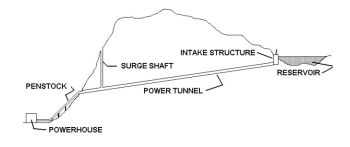Tunnels: Difference between revisions
From ASDSO Dam Safety Toolbox
No edit summary |
No edit summary |
||
| (5 intermediate revisions by 3 users not shown) | |||
| Line 1: | Line 1: | ||
<!-- Delete any sections that are not necessary to your topic. Add pictures/sections as needed --> | <!-- Delete any sections that are not necessary to your topic. Add pictures/sections as needed --> | ||
__NOTOC__ | __NOTOC__ | ||
[[Category:Water Conveyance]] | |||
---- | ---- | ||
{{Picture | |||
<!-- Add image file name (ex.image.jpg) --> | |||
|image=tunnel1.jpg | |||
<!--Add link if applicable --> | |||
|link= | |||
<!-- Add picture caption --> | |||
|caption=Typical tunnel diagram | |||
(Image Source: FERC) | |||
}} | |||
<!-- Introductory paragraph or topic page summary --> | <!-- Introductory paragraph or topic page summary --> | ||
Tunnels are long underground excavations with two or more openings to the surface, usually having a uniform cross section used for access, conveying flows, etc. Tunnels are most often used in mountainous areas. Tunnels can be divided into two basic types, lined and unlined. | Tunnels are long underground excavations with two or more openings to the surface, usually having a uniform cross section used for access, conveying flows, etc. Tunnels are most often used in mountainous areas. Tunnels can be divided into two basic types, lined and unlined. | ||
==Best Practices Resources== | <noautolinks>==Best Practices Resources==</noautolinks> | ||
{{Document Icon}} [[Engineering Guidelines for the Evaluation of Hydropower Projects: Chapter 12- Water Conveyance| Engineering Guidelines for the Evaluation of Hydropower Projects: Chapter 12- Water Conveyance | {{Document Icon}} [[Engineering Guidelines for the Evaluation of Hydropower Projects: Chapter 12- Water Conveyance| Engineering Guidelines for the Evaluation of Hydropower Projects: Chapter 12- Water Conveyance, FERC]] | ||
{{Document Icon}} [[Design Standards No. 3: Water Conveyance Facilities, Fish Facilities, and Roads and Bridges (Ch. 4: Tunnels, Shafts, and Caverns)| Design Standards No. 3: Water Conveyance Facilities, Fish Facilities, and Roads and Bridges (Ch. 4: Tunnels, Shafts, and Caverns) | {{Document Icon}} [[Design Standards No. 3: Water Conveyance Facilities, Fish Facilities, and Roads and Bridges (Ch. 4: Tunnels, Shafts, and Caverns)| Design Standards No. 3: Water Conveyance Facilities, Fish Facilities, and Roads and Bridges (Ch. 4: Tunnels, Shafts, and Caverns), USBR]] | ||
<!-- In the location of an in text citation, simply enclose the citation as follows: <ref> citation </ref>. Citations will automatically populate. Learn more at https://www.mediawiki.org/wiki/Help:Cite. --> | <!-- In the location of an in text citation, simply enclose the citation as follows: <ref> citation </ref>. Citations will automatically populate. Learn more at https://www.mediawiki.org/wiki/Help:Cite. --> | ||
Latest revision as of 22:31, 18 July 2023

|
| Typical tunnel diagram
(Image Source: FERC) |
Tunnels are long underground excavations with two or more openings to the surface, usually having a uniform cross section used for access, conveying flows, etc. Tunnels are most often used in mountainous areas. Tunnels can be divided into two basic types, lined and unlined.
Best Practices Resources
![]() Engineering Guidelines for the Evaluation of Hydropower Projects: Chapter 12- Water Conveyance, FERC
Engineering Guidelines for the Evaluation of Hydropower Projects: Chapter 12- Water Conveyance, FERC
Citations:
Revision ID: 7319
Revision Date: 07/18/2023
